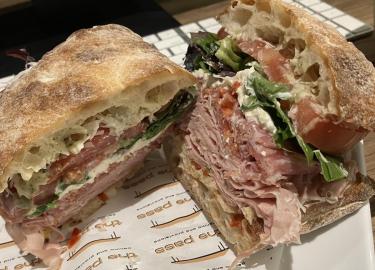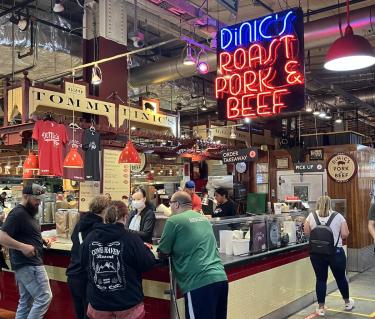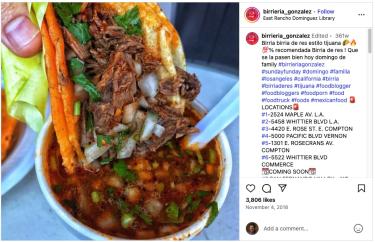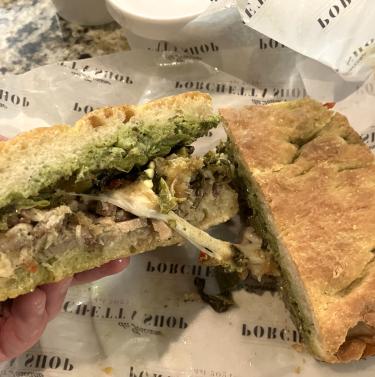Still Waiting for Charleston's Signature Sandwich
Plus a little sandwich origin theory
Posted October 10, 2025
10-10 2025

Almost a decade ago I wrote an article for the Charleston City Paper posing the question, “Where is Charleston’s signature sandwich?”
After all, Philadelphia has its cheesesteaks, and New Orleans its poor boys. When in Baltimore, a pit beef sandwich topped with tiger sauce is a must, and no trip to Chicago would be complete without an Italian beef or two. So why is it that Charleston, one of America’s leading culinary cities, still has no signature sandwich to call its own?
In the original piece, I mapped out a theory of signature sandwich formation—what works, what doesn’t—and challenged local culinarians to get on it. Noting that it takes time for such creations to take root in a city’s dining scene, I closed by promising, “I’ll check back in in five years or so and see how it’s going.”
I’m now five years overdue on that promise, so I’m finally going to revisit the topic and see how we are doing.
The answer, I’m afraid, is “not so well”.
Some Signature Sandwich Theory
Before we assess the current situation, let’s dig into the topic of how a sandwich becomes a city’s signature sandwich.
We have plenty of cases to study. Los Angeles lays claim to the French dip, and Boston to the lobster roll. There are Cuban sandwiches in Tampa and Miami (the two cities debate which came first), beef on weck in Buffalo, and loose meat sandwiches in Des Moines. Don’t forget the Hot Brown in Louisville and the half-smoke in Washington, D.C. (Yes, I know that last one is a hot dog, and I’m not going to rehash the whole “is a hot dog a sandwich?” debate. For the purposes of this study, it’s a sandwich.)
Philadelphia and New Orleans, ever the strivers, even have backup signature sandwiches: the roast pork with broccoli rabe in the Friendly City and the muffuletta — a big round loaf stuffed with sliced deli meats, cheese, and olive salad — down in the Big Easy.

Just up the road from me, Columbia, South Carolina, has its own hallmark sandwich: the pimento burger. It was most likely created at the now-departed Dairy Bar on Main Street, and it can still be had around the city at wonderful old-school joints like the Kingsman and Mack’s Cash Grocery.
For all the cities that have signature sandwiches, though, there are still plenty of places that don’t. If you ask folks in such a city (Charleston, for instance) to dream up what their town’s signature sandwich could be, they tend to go down the same path.
What kind of food or dishes is Charleston best known for? Let’s take one, slap it between two slices of bread, and see what happens. How about . . . a shrimp and grits sandwich? Patty and fry the grits, top them with shrimp, and layer them on a seeded kaiser roll!
No. That’s awful. Let’s try again. Charleston is famous for fresh, locally-caught fish. Maybe a blackened triggerfish sandwich? Put it on a benne seed bun and slather it with mustard-based BBQ sauce! Genius!
We sold two in the first month and took it off the menu.
Signature sandwiches can’t be created on demand by committee. We can find some clues about what does work by studying how other cities’ signature sandwiches came to be.
The cheesesteak, for instance. Around 1930, Harry and Pat Olivieri were running a hot dog stand in South Philadelphia. One of the brothers came up with a sandwich made of sliced beef and grilled onions on a roll. It proved popular with customers, but its rise to city-wide fame was slow and evolutionary. In 1940 the brothers opened “Pat’s King of Steaks” at the intersection of East Passyunk Avenue and 9th Street, and they didn’t add cheese to their sandwich until sometime in the 1950s.
The cheesesteak didn’t truly arrive as a civic specialty until after 1966, when Joe Venot opened a competing stand called Geno’s Steaks diagonally across the intersection from Pat’s. People have been arguing ever since about which of the two stands has the city’s best steaks. (The proper answer is “neither,” since the best are found downtown at Jim’s.)
The New Orleans poor boy gained its signature status a bit faster, but the process was still measured in years, not months. In 1929, the most widely-repeated story goes, local streetcar workers went on strike, and Bennie and Clovis Martin of the Martin Brothers’ Restaurant, themselves former streetcar conductors, offered free meals to help out union members. They concocted for the strikers hearty roast beef sandwiches on 40-inch long French loaves from local baker John Gendusa. Years later, when asked where the sandwich’s name came from, Bennie Martin recalled, “We fed those men free of charge until the strike ended. Whenever we saw one of the striking men coming, one of us would say, ‘Here comes another poor boy.’”
The accuracy of this story is questionable, and others have claimed to have invented the sandwich around the same time. (We’ll dig into that whole mess in a later post.) What is certain is that by 1931 the city was dotted with shops and stands — including Tony’s Poor Boy Sandwich Shop and the Poor Boy Sandwich Stand — offering similar oversized creations.
As these stories suggest, the mechanisms of sandwich signatureization can be a little counterintuitive. Does a city’s marquee sandwich need to be made with some sort of uniquely local ingredient? Absolutely not. The original New Orleans poor boy was made not with crawfish or blackened redfish but with roast beef. The Philly cheesesteak? Also beef, though Philly isn’t particularly known for fine steaks. Baltimore is famous for blue crabs, but its signature sandwich is made from beef, too (sense a theme?), in this case a top or bottom round roast grilled over a charcoal fire (i.e. “pit beef.”)
Not every city’s signature sandwich is beef-based. Both the Miami and the Tampa Cuban sandwiches have layers of ham and pork, while Louisville’s Hot Brown uses turkey. None of these places are noted pork or turkey producers. Apart perhaps from the lobster on Boston’s lobster roll, the proteins in the middle don’t have a particular local identity.
What really matters is where you put that meat, which is to say the bread. The Philly cheesesteak depends upon a specific type of roll: a hearth-baked Amoroso roll that is light and crisp on the outside but soft in the middle. The poor boy rose to fame on its distinctive 40-inch Gendusa roll, and New Orleans’s second-string signature sandwich takes its very name from the bread it’s on, for a muffuletta is a specific type of round, flat Sicilian loaf. Ditto for Buffalo’s beef-on-weck (look, more beef!), which gets its name from kummelweck, a Kaiser-like roll topped with caraway seeds and pretzel salt that, until recently, could only be found in and around Buffalo and Rochester, New York.
These sandwiches mostly originated in working-class establishments—hot dog stands, sandwich shops, bars—and often in immigrant neighborhoods. They were originally something diners grabbed for a quick, hearty lunch or to soak up the booze during a night on the town. The sandwiches’ statures grew slowly and quietly, as other restaurateurs copied a popular item one of their competitors was serving — what we might call the Pat & Geno Effect.
Most important, no one outside of the originating city heard about those sandwiches for years, so they had time to take root and evolve and become part of their city’s distinctive food culture.
Can We Create a Signature Sandwich Today?
Perhaps tellingly, all of these signature sandwiches originated decades ago. It’s hard to imagine something like a beef-on-weck or a Cuban sandwich emerging in this era of hyper-connected digital media.
Take the birria taco. (I know, I know. I will go to the mat about the hot dog, but not even I am stubborn enough to argue that a taco is a sandwich. The example is still informative, though.)
Birria de res tacos originated decades ago at breakfast taco carts in 1980s Tijuana, as Bill Esparza documented in a fine Eater piece called, “The Great Birria Boom.” A trio of brothers name Oscar, Ivan, and Omar Gonzalez began selling them at their taco truck in South Central Los Angeles in 2015, and a few other trucks followed their lead. It was a single Instagram post in 2018, though, that sparked the explosion.

“Social media influencers,” Esparza writes, and “the mobile fleet of social media-savvy birrieros . . . flooded the internet with images of red tacos plunged into cups of crimson consomme. With post after birria-dunking post, LA’s Mexican food trucks won followers and customers.” Within months, food trucks in San Francisco, Portland, and New York City were slinging birria tacos left and right, and they quickly became staples in barbecue joints in Texas and the Carolinas. Connoisseurs may be aware of the tacos’ roots in South Central L.A., but most Americans don’t associate them with any one city. They blew up too fast for that.
These days, when restaurateurs want to add something novel to their menus, they don’t need to walk down the block and check out their competitors. Social media and the Internet offer infinite sources of inspiration from around the country and, indeed, all over the world. Thus we have Charleston restaurants offering bánh mì and Nashville hot chicken sandwiches and any number of other far-flung things. It’s great for the culinary diversity of our local scene, but it’s a recipe for sandwich imitation, not sandwich innovation.
Still Waiting for that Signature Sandwich
Ten years after I first issued the challenge, Charleston’s sandwich-makers have still not come forward with a uniquely local “handheld” or “between the bread”, as our cutesy menu-writers have taken to calling the category.
We have, however, adopted any number of different sandwiches from other places. At Da Toscano Porchetta Shop, Michael Toscano is layering sliced porchetta (Italy’s answer to turducken) on slabs of fresh-baked focaccia. A bunch of New Yorkers imported bodega-style bacon, egg, and cheese breakfast sandwiches and built a restaurant named Bodega around them. Philly native Anthony Marini is piling sliced Italian meats on ciabatta rolls at the Pass. These are all delicious sandwiches, but they’ll never become iconic Charleston specialities.

So let me repeat my call and map out what needs to happen if Charleston is going to someday have its own signature sandwich.
Step 1: Someone has to come up with a really good sandwich. Roast beef would be a promising filling, but the real key will be having the right roll or bread—and not focaccia or ciabatta or something you can find just about anywhere (I’m looking your way, Normandy Farm and Welton’s and Grit Bakery . . .)
Step 2: A couple of other restaurants need to shamelessly rip off that sandwich and start selling their own versions, and everyone here in town needs to start eating them all the time so that even more restaurants start offering it.
Step 3: This is the most important part. Everybody needs to shut up about it, especially the foodie “influencer” types. We can’t let word get out for at least four or five years. No Instagram Reels, no TikToks, no breathless mentions in “16 Sandwiches from Coast to Coast to Try Before You Die.”
Let’s get serious this time, Charleston. I know we can do it. I’ll give it another five years or so and check in to see how it’s going.
This story was published in my Robert F. Moss Substack newsletter. You can subscribe for free and have my latest dispatches sent directly to your email inbox.
About the Author
Robert F. Moss
Robert F. Moss is the Contributing Barbecue Editor for Southern Living magazine and the author of six books on food, drink, and travel, including The Lost Southern Chefs, Barbecue: The History of an American Institution, Southern Spirits: 400 Years of Drinking in the American South, and Barbecue Lovers: The Carolinas. He lives in Charleston, South Carolina.